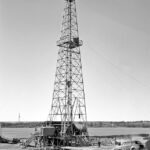Beneath our feet, hidden from our everyday view, lies a world of infrastructure that plays a crucial role in our modern lives. One of the unsung heroes of this underground realm is the manhole. Often overlooked and taken for granted, manholes are an integral part of urban infrastructure that facilitates various essential functions. In this article, we will delve into the world of manholes, exploring their history, purpose, design, and significance in today’s society.
The Historical Evolution of Manholes
Manholes, in some form or another, have been part of human civilization for centuries. Ancient civilizations used openings in the ground to access sewage systems, water channels, and other underground structures. However, it was during the Industrial Revolution that manholes as we know them began to take shape.
The advent of large-scale urbanization and the need for efficient sanitation systems led to the development of more sophisticated sewer networks. In the mid-19th century, cities like London and Paris started implementing comprehensive sewage systems with access points for maintenance and repair. These access points eventually evolved into the standardized manholes we recognize today.
What is a Manhole?
A manhole is a vertical opening or access point, usually covered with a lid or cover, that provides entry into underground utility systems such as sewage networks, stormwater drainage systems, water supply pipelines, gas lines, and telecommunication cables. Manholes allow for maintenance, inspection, repair, and cleaning of these underground structures, as well as serving as safety features by preventing accidents and providing emergency access. They are an integral part of urban infrastructure, facilitating the proper functioning of various utilities while ensuring the safety of pedestrians and vehicles above. Manholes are also known as inspection chambers. Fig. 1 below shows a typical manhole.

The Purpose and Functionality of Manholes
Manholes serve several essential functions in urban infrastructure:
Access and Maintenance:
Manholes provide access points to underground utility networks such as sewage systems, stormwater drainage, water supply lines, gas pipelines, and telecommunication cables. Maintenance crews use manholes to inspect, clean, and repair these systems without the need for extensive excavation.
Safety:
Manholes also serve as safety features. They prevent accidents by covering open pits and trenches, reducing the risk of pedestrians and vehicles falling into underground passages.
Ventilation:
In sewer systems, manholes play a role in ventilation. They allow gases produced by the decomposition of waste to escape, preventing the buildup of potentially dangerous fumes.
Emergency Access:
Manholes can serve as emergency access points for first responders to reach underground areas quickly, such as during gas leaks or other hazardous incidents.
Features of a Manhole
Manholes are designed with several key features to fulfill their important roles in urban infrastructure. The specific features of a manhole can vary based on its intended use, location, and the utility systems it provides access to. Here are the main features commonly found in a manhole:
Access Opening or Access Shaft:
The primary purpose of a manhole is to provide access to underground utility systems. This opening is typically located at ground level and is covered with a lid or cover to prevent unauthorized entry and ensure safety.
In general, manholes are positioned 500 mm away from the curb lines of the road such that it is away from the traffic wheel line. The access shaft consists is designed a 700 mm diameter for a circular opening and a 750 mm X 600 mm opening for a rectangular chamber.
Manhole Cover or Lid:
The cover or lid is a critical component of a manhole. It is designed to bear the weight of pedestrian and vehicular traffic and protect the opening from debris, water, and other elements. Manhole covers can come in various shapes (round, square, rectangular) and materials (precast concrete, metal, composite materials), depending on factors like traffic load and aesthetic considerations. The weight of the cover including the frame usually ranges from 90 Kg to 270 Kg.
Frame:
The frame is the structure that surrounds the access opening and provides support for the cover or lid. It helps distribute the weight load and prevents the cover from sinking into the manhole. The frame can also have features like locking mechanisms for security purposes.
Shaft or Barrel:
The shaft or barrel is the vertical portion of the manhole that extends below ground level. It connects the access opening at the top to the underground utility system. The diameter and depth of the shaft can vary based on the size and purpose of the manhole.
Steps or Ladder:
In larger manholes, steps or a ladder may be incorporated to facilitate safe entry and exit for maintenance workers. These steps are usually made of non-slip materials and are designed to withstand the conditions within the manhole. When the manhole depth is less than 1000 mm, a step ladder is constructed. But when the depth is more than 2500 mm, a rectangular ladder is added. Note that, physical entry is not required in most of the modern manholes.
Benching:
The interior base of the manhole often features a bench or platform. This flat surface allows maintenance workers to stand or place tools while performing tasks within the manhole. The design of the bench helps prevent the accumulation of debris and provides stability.
Sealing Mechanism:
Manholes are equipped with sealing mechanisms to prevent water infiltration, debris, and odors from entering underground utility systems. This sealing mechanism can consist of gaskets, seals, or other types of barriers.
Ventilation Openings:
In sewer systems, manholes may include ventilation openings to allow gases produced by decomposing waste to escape. These openings help prevent the buildup of dangerous gases within the manhole.
Identification Markings:
Manhole covers often bear identification markings that indicate the type of utility system they provide access to, along with other relevant information for maintenance crews and emergency responders.
Security Features:
Some manholes in sensitive areas may be equipped with security features such as locking mechanisms or electronic access controls to prevent unauthorized entry.
Smart Technology Integration:
With advancements in technology, some manholes are being equipped with sensors and data collection systems to monitor the condition of underground infrastructure in real-time. These smart manholes can help detect issues early and improve maintenance efficiency.
Manhole Types
Manholes can be classified depending on various parameters like depth, application, construction, etc.
Types of Manholes Depending on the Depth
Manholes can be categorized based on their depth, as the depth of a manhole influences its design, construction, and purpose. Here are four different types of manholes based on depth:
Shallow Manholes:
Shallow manholes are typically those that have a depth of up to around 1.0 meters. These manholes are often found in areas with relatively shallow utility systems, such as stormwater drains, smaller sewer lines, or telecommunications cables. Shallow manholes are easier to access and maintain, as they require less effort for entry and exit. They are provided with a light cover.
Normal or Intermediate Manholes:
Intermediate manholes fall within a depth range of around 1.0 to 1.5 meters. These manholes are commonly used for accessing utility systems that are located at a moderate depth, such as larger sewer lines, water supply pipelines, and some electrical cables. Intermediate manholes strike a balance between accessibility and the depth of the utility system they provide access. They have a heavier cover than the shallow manholes.
Deep Manholes:
Deep manholes are those with depths exceeding 1.5 meters. These manholes are used to access utility systems located at greater depths, such as large-diameter sewer mains, deep water supply lines, and deep underground cables. Due to their greater depth, deep manholes often require additional safety measures, such as proper lighting, ventilation, and fall protection for workers.
Extreme Depth Manholes:
In some cases, manholes can be extremely deep, reaching depths of more than 3 meters or more. These manholes are relatively rare and are often found in complex utility systems or areas with significant topographical challenges. Extreme-depth manholes may require specialized equipment and training for maintenance and repair tasks.
Depending on the application of the manhole they are classified as follows:
Utility Manholes:
These are the most common type of manholes and provide access to a variety of utility systems, including sewage, stormwater drainage, water supply pipelines, gas lines, and telecommunication cables. Utility manholes are usually found along streets, sidewalks, and other urban areas.
Stormwater Manholes:
Designed specifically for stormwater drainage systems, these manholes help manage rainwater runoff, preventing flooding and erosion. They often include features such as sediment traps to capture debris and prevent it from entering the drainage network.
Sanitary Sewer Manholes:
These manholes provide access to sanitary sewer systems, which carry wastewater from homes and businesses to treatment facilities. Sanitary sewer manholes are designed to prevent the infiltration of groundwater and to contain the flow of sewage.
Combination Manholes:
These manholes serve as access points for both stormwater and sanitary sewer systems. They are often used in areas where these two systems overlap or are interconnected.
Water Utility Manholes:
Water utility manholes provide access to water supply pipelines. They are essential for maintenance, repair, and valve operation in water distribution systems.
Gas Utility Manholes:
These manholes provide access to gas pipelines. They are used for the maintenance, inspection, and repair of the gas distribution network.
Telecommunication Manholes:
Also known as communication vaults or telecom manholes, these provide access to underground telecommunication cables and equipment. They are crucial for the maintenance and expansion of communication networks.
Electrical Utility Manholes:
These manholes provide access to underground electrical cables and equipment. They are essential for the maintenance and repair of electrical distribution systems.
Again, depending on the manhole construction methods/materials, the following types of manholes are found:
Precast Manholes:
Precast manholes are factory-made and preassembled units that are transported to the site and installed. They offer consistent quality, quick installation, and reduced construction time.
Brick or Masonry Manholes:
Historically common, these manholes are constructed using bricks or masonry materials. While less common today due to the prevalence of more durable materials, they can still be found in older urban areas.
Composite Manholes:
Composite materials, such as fiberglass-reinforced plastic (FRP), are being used to create lightweight yet strong manholes. These materials offer resistance to corrosion and are ideal for challenging environments. Refer to Fig. 2

There are some other types of manholes as well:
Decorative Manholes:
In certain areas, manholes are designed to blend with the aesthetic of the surroundings. These decorative manholes often feature artistic designs, patterns, or logos that reflect the local culture or history.
Specialty Manholes:
Depending on the utility and specific requirements, specialty manholes can be designed. For instance, vacuum manholes are used in vacuum sewer systems, which rely on negative pressure to transport sewage.
Smart Manholes:
With the integration of sensors and data collection technology, smart manholes monitor parameters like flow rates, levels, and conditions. They provide real-time data for maintenance and management.
Multi-Level Manholes:
Multi-level manholes, also known as drop manholes, consist of multiple platforms or levels within a single manhole structure. These manholes are used in situations where utility lines at different depths intersect or converge. Multi-level manholes facilitate access to various utility systems while minimizing the need for separate manholes.
Sump Manholes:
Sump manholes are designed with a sump at the bottom to collect sediment, debris, and other materials that may accumulate in the utility system. These manholes are often used in stormwater drainage systems to prevent clogging and maintain effective water flow.
Location of Manholes
Manholes are strategically located throughout urban areas to provide access to various utility systems and to ensure the proper functioning of these systems. The placement of manholes is determined by factors such as the type of utility, the layout of the city, traffic patterns, maintenance needs, and safety considerations. Here are some common locations where manholes can be found:
Streets and Roadways:
Manholes are often placed along streets and roadways to provide access to underground utility systems such as sewage, stormwater drainage, water supply lines, and gas pipelines. They are usually positioned at regular intervals to allow for efficient maintenance and repairs.
Sidewalks and Pedestrian Areas:
Manholes can be found on sidewalks and pedestrian pathways, particularly in urban areas where utility lines run beneath foot traffic. These manholes are designed to be safe and unobtrusive to pedestrians.
Intersections:
Manholes are commonly located at intersections of streets and roads. This positioning allows for easy access to utility systems that may intersect or converge at these points.
Curbs and Gutters:
Manholes are sometimes placed near curbs and gutters to provide access to stormwater drainage systems. These manholes help manage rainwater runoff and prevent flooding.
Alleys:
In some areas, manholes are placed in alleys to provide access to utility systems while minimizing disruption to main roads and sidewalks.
Public Spaces:
Manholes may also be located in public spaces such as parks, plazas, and open areas. While less common, these manholes serve utility systems that are essential to maintaining these spaces.
Residential Areas:
In residential neighborhoods, manholes are often placed along streets or in areas where utility lines are present. These manholes provide access to sewage and water supply systems serving homes.
Industrial Areas:
In industrial zones, manholes may be strategically placed to provide access to utility systems required for industrial processes, such as water supply, wastewater disposal, and energy distribution.
Commercial Districts:
Manholes can be found in commercial areas to provide access to utility systems that support businesses, such as telecommunication cables and gas lines.
Emergency Access Routes:
Manholes can serve as emergency access points for first responders to reach utility systems quickly in case of emergencies.
Public Transportation Infrastructure:
Manholes can be located near public transportation infrastructure like subway stations and bus stops to provide access to utility systems that support these services.
Sensitive Areas:
In areas where there are historical landmarks, archaeological sites, or environmentally sensitive zones, manholes may be carefully placed to minimize disturbance while still allowing for necessary access.
Manhole Cover Materials
Manhole covers are designed to be durable, strong, and capable of withstanding various environmental conditions, traffic loads, and wear and tear. As a result, they are often made from a variety of materials, each with its own set of advantages and considerations. There are majorly two materials that are used for the construction of manhole covers; Cast Iron and Concrete. Fig. 3 shows some typical Manhole Covers.

Cast Iron:
Cast iron is one of the most traditional and widely used materials for manhole covers. It is known for its strength and durability, making it suitable for heavy traffic areas. Cast iron covers can be coated with materials like bitumen or epoxy to enhance corrosion resistance.
Concrete:
Concrete manhole covers are common in areas where there is less vehicular traffic. They are durable and can be customized in terms of size and design. Concrete covers are often used in sidewalks and pedestrian areas.
However, with recent advancements, various other materials are used for producing manhole covers. Some of them are:
- Ductile Iron
- Steel
- Composite Materials like FRP, GRP
- Polymer Concrete
- Composite Reinforced Concrete, etc
Design and Construction of Manholes
Manholes come in various shapes and sizes, depending on their function and location. Common designs include round, square, and rectangular manholes. The choice of design depends on factors such as the type of utility, the volume of traffic above, and aesthetic considerations.
Manholes are typically constructed using durable materials such as concrete, brick, or composite materials. The cover or lid of a manhole is designed to withstand the weight of pedestrian and vehicular traffic, and some even incorporate locking mechanisms for security.
Significance of Manholes in Modern Society
In today’s rapidly evolving urban landscape, manholes remain crucial to maintaining the functionality of cities. As cities expand, their utility networks become more complex, making regular maintenance and efficient access points even more critical. Additionally, manholes contribute to the overall aesthetics of urban areas, especially in historical or architecturally significant neighborhoods.
However, manholes are also undergoing innovation. Smart manholes equipped with sensors and data collection systems are being developed to monitor the condition of underground infrastructure in real time. This technology can help detect leaks, blockages, and other issues early, minimizing disruptions and reducing the need for extensive maintenance.
Why is the Manhole Cover made Round in Shape?
The choice of a round shape for manhole covers is not arbitrary; it is based on practical considerations and engineering principles. There are several reasons why manhole covers are typically designed with a circular shape:
1. No Orientation:
A circular shape has no distinct orientation, meaning it can be placed in any direction and still fit perfectly over the manhole opening. This eliminates the need to align the cover correctly, which is not the case with other shapes like squares or rectangles.
2. Stability:
A circular shape distributes weight evenly around its circumference, making it stable under various loads. This distribution of weight ensures that the cover won’t easily tip or fall into the manhole, even if there’s a heavy vehicle passing over it.
3. Ease of Handling:
Round manhole covers can be rolled to their location, making them easier to transport and install. This is particularly advantageous when considering the weight of some covers and the potential for injury during installation.
4. Preventing Falls:
The absence of corners or edges on a circular manhole cover reduces the risk of accidents. Sharp corners on square or rectangular covers could potentially cause pedestrians or vehicle tires to catch, leading to accidents.
5. Uniform Pressure Distribution:
When a circular cover is subjected to pressure, the load is evenly distributed across its surface. In contrast, square or rectangular covers might experience concentrated stress at the corners, potentially leading to cracking or breaking.
How much does a Manhole Cover Weigh?
The weight of a manhole cover can vary significantly based on factors such as the material used, the size of the cover, the intended load-bearing capacity, and the specific utility system it provides access to. Here are approximate weight ranges for manhole covers made from different materials:
- Cast Iron: Cast iron manhole covers, which are common in many urban areas, can weigh anywhere from 50 to 300 kilograms (110 to 660 pounds) or more, depending on their size and load-bearing capacity.
- Ductile Iron: Ductile iron manhole covers, which are a more modern variation of cast iron, are often lighter due to their improved properties. They can weigh between 30 to 180 kilograms (66 to 396 pounds) or more.
- Concrete: Concrete manhole covers are generally heavier than their metal counterparts. They can weigh around 90 to 300 kilograms (200 to 660 pounds) or more, depending on their size and thickness.
- Composite Materials: Composite manhole covers made from materials like fiberglass-reinforced plastic (FRP) or other composites are much lighter compared to metal or concrete covers. They typically weigh between 10 to 60 kilograms (22 to 132 pounds) or more.
- Steel: Steel manhole covers are also quite heavy, similar to cast iron covers. They can weigh around 50 to 300 kilograms (110 to 660 pounds) or more.
- Aluminum: Aluminum manhole covers are lightweight compared to cast iron and steel. They usually weigh between 10 to 50 kilograms (22 to 110 pounds) or more.
Conclusion
The humble manhole, with its unassuming presence, plays a pivotal role in the intricate web of urban infrastructure. It has evolved from simple openings in the ground to sophisticated access points that enable the efficient functioning of utility networks. As our cities continue to grow and modernize, manholes will remain indispensable, reminding us that even the hidden components of our urban landscape deserve our attention and appreciation.






